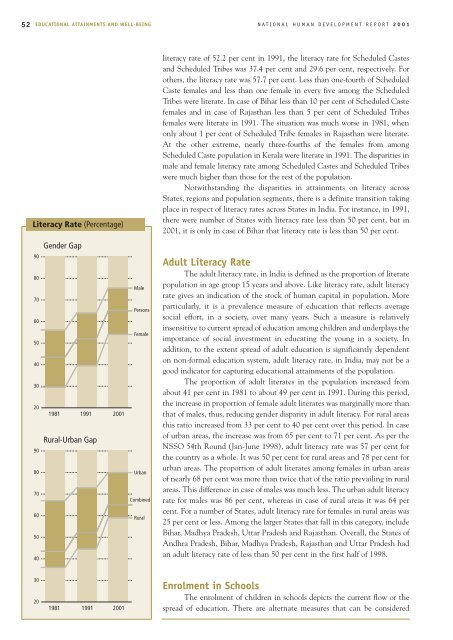National Human Development Report: 2001 - Indira Gandhi Institute ...
National Human Development Report: 2001 - Indira Gandhi Institute ...
National Human Development Report: 2001 - Indira Gandhi Institute ...
- No tags were found...
Create successful ePaper yourself
Turn your PDF publications into a flip-book with our unique Google optimized e-Paper software.
52EDUCATIONAL ATTAINMENTS AND WELL-BEINGNATIONAL HUMAN DEVELOPMENT REPORT <strong>2001</strong>Literacy Rate (Percentage)literacy rate of 52.2 per cent in 1991, the literacy rate for Scheduled Castesand Scheduled Tribes was 37.4 per cent and 29.6 per cent, respectively. Forothers, the literacy rate was 57.7 per cent. Less than one-fourth of ScheduledCaste females and less than one female in every five among the ScheduledTribes were literate. In case of Bihar less than 10 per cent of Scheduled Castefemales and in case of Rajasthan less than 5 per cent of Scheduled Tribesfemales were literate in 1991. The situation was much worse in 1981, whenonly about 1 per cent of Scheduled Tribe females in Rajasthan were literate.At the other extreme, nearly three-fourths of the females from amongScheduled Caste population in Kerala were literate in 1991. The disparities inmale and female literacy rate among Scheduled Castes and Scheduled Tribeswere much higher than those for the rest of the population.Notwithstanding the disparities in attainments on literacy acrossStates, regions and population segments, there is a definite transition takingplace in respect of literacy rates across States in India. For instance, in 1991,there were number of States with literacy rate less than 50 per cent, but in<strong>2001</strong>, it is only in case of Bihar that literacy rate is less than 50 per cent.Gender Gap90807060504030209080706050401981 1991 <strong>2001</strong>Rural-Urban GapMalePersonsFemaleUrbanCombinedRuralAdult Literacy RateThe adult literacy rate, in India is defined as the proportion of literatepopulation in age group 15 years and above. Like literacy rate, adult literacyrate gives an indication of the stock of human capital in population. Moreparticularly, it is a prevalence measure of education that reflects averagesocial effort, in a society, over many years. Such a measure is relativelyinsensitive to current spread of education among children and underplays theimportance of social investment in educating the young in a society. Inaddition, to the extent spread of adult education is significantly dependenton non-formal education system, adult literacy rate, in India, may not be agood indicator for capturing educational attainments of the population.The proportion of adult literates in the population increased fromabout 41 per cent in 1981 to about 49 per cent in 1991. During this period,the increase in proportion of female adult literates was marginally more thanthat of males, thus, reducing gender disparity in adult literacy. For rural areasthis ratio increased from 33 per cent to 40 per cent over this period. In caseof urban areas, the increase was from 65 per cent to 71 per cent. As per theNSSO 54th Round (Jan-June 1998), adult literacy rate was 57 per cent forthe country as a whole. It was 50 per cent for rural areas and 78 per cent forurban areas. The proportion of adult literates among females in urban areasof nearly 68 per cent was more than twice that of the ratio prevailing in ruralareas. This difference in case of males was much less. The urban adult literacyrate for males was 86 per cent, whereas in case of rural areas it was 64 percent. For a number of States, adult literacy rate for females in rural areas was25 per cent or less. Among the larger States that fall in this category, includeBihar, Madhya Pradesh, Uttar Pradesh and Rajasthan. Overall, the States ofAndhra Pradesh, Bihar, Madhya Pradesh, Rajasthan and Uttar Pradesh hadan adult literacy rate of less than 50 per cent in the first half of 1998.30201981 1991 <strong>2001</strong>Enrolment in SchoolsThe enrolment of children in schools depicts the current flow or thespread of education. There are alternate measures that can be considered

















